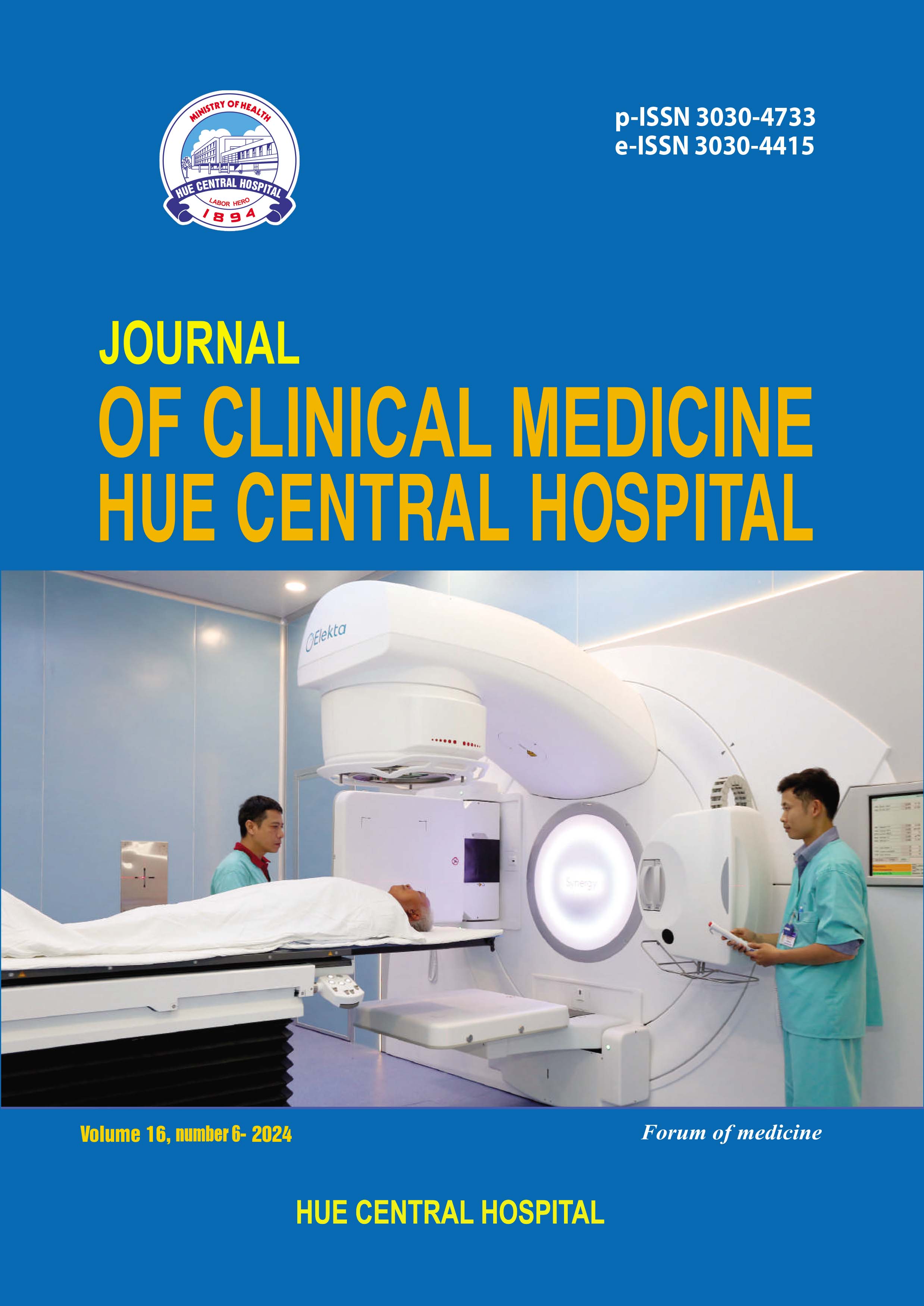Abstract
Background: Salivary tumour is one of the most frequent tumour of the head, face and neck region. The diagnosis and classification of salivary tumour are complicated and in many cases it is quite difficult to differentiate the diseases just basing on the clinical signs and imaging diagnosis. The international researches have shown that cytology played a meaningful role in practice for the early diagnosis and orientating the suitable treatment. This study aims to classify the cytology and histopathology of salivary tumours, 2. To assess the role of cytology in the diagnosis of salivary tumours compared with histopathology.
Methods: Cross-sectional research on 74 patients diagnosed by cytology and histopathology at the Hospital of Hue University of Medicine and Pharmacy from 07.2022 to 12.2023.
Results: Cytology: most of them were benign 97.3% (72/74 cases) including Milan group IV 60.8% (pleomorphic adenomas 28.4%, Warthin’s tumour 13.5%, other adenomas 18.9), Milan group II 36.5% (inflammation 16.2%, cystic lesions 14.9% and the less frequent ones encompassing fibro-lipoma, reactive lymph nodes); 2/74 were Milan group VI (2.7%). Histopathology: 71/74 cases (95.9%) were benign, in which two most frequent types of tumour were pleomorphic adenomas and Warthin’s tumour (41.9%, 40.5%), the less ones including cystic tumours, lipoma, lympho – epithelial tumour, basal cell adenoma; 3/74 cases (4.1%) were malignant with the subtypes such as mucoepidermoid carcinoma, adenoid cystic carcinoma and acinic cell carcinoma; Cytology plays a meaningful role in the diagnosis of salivary tumour with the sensitivity, specificity and accuracy were 33,3%, 98,6%, 95,9% respectively.
Conclusions: Cytology was valuable in the diagnosis of salivary tumour with the very high specificity (98.6%) so we should apply this method in practice for the early diagnosis and suitable treatment.
Key words: Salivary tumour, parotid salivary gland, cytology, histopathology, pleomorphic adenoma, mucoepidermoid carcinoma
References
Sando Z, Fokouo JV, Mebada AO, et al. Epidemiological and histopathological patterns of salivary gland tumors in Cameroon. Pan Afr Med J. 2016; 23:66.
Alvi S, Chudek D, and Limaiem F. Parotid Cancer. StatPearls, StatPearls Publishing Copyright © 2021, StatPearls Publishing LLC, Treasure Island (FL).
Vuhahula EA. Salivary gland tumors in Uganda: clinical pathological study. Afr Health Sci. 2004; 4(1): 15-23.
Seethala RR and Stenman G. Update from the 4th Edition of the World Health Organization Classification of Head and
Neck Tumours: Tumors of the Salivary Gland. Head Neck Pathol. 2017; 11(1): 55-67.
Thielker J, Grosheva M, Ihrler S, et al. Contemporary Management of Benign and Malignant Parotid Tumors. Front Surg. 2018; 5:39.
Israel Y, Rachmiel A, Ziv G, et al. Benign and Malignant Salivary Gland Tumors - Clinical and Demographic Characteristics. Anticancer Res. 2016; 36(8):4151-4.
Ngô Ngọc Liên. Bệnh học tai mũi họng - đầu mặt cổ. Nhà xuất bản Y học. 2006. 519 - 522.
Correia-Sá I, Correia-Sá M, Costa-Ferreira P, et al. Fineneedle aspiration cytology (FNAC): is it useful in preoperative diagnosis of parotid gland lesions? Acta Chir Belg. 2017; 117(2):110-114.
Bialek EJ, Jakubowski W, Zajkowski P, et al. US of the major salivary glands: anatomy and spatial relationships, pathologic conditions, and pitfalls. Radiographics. 2006; 26(3):745-63.
Das DK, Petkar M A, Al-Mane N M, et al. Role of fine needle aspiration cytology in the diagnosis of swellings in the salivary gland regions: a study of 712 cases. Med Princ Pract. 2004; 13(2):95-106.
Lubin D, Buonocore D, Wei XJ, et al. The Milan System at Memorial Sloan Kettering: Utility of the categorization system for in-house salivary gland fine-needle aspiration cytology at a comprehensive cancer center. Diagn Cytopathol. 2020; 48(3):183-190.
Hứa Thị Ngọc Hà, Hứa Chí Minh và Nguyễn Văn Thành. Giá trị chẩn đoán của phương pháp chọc hút tế bào bằng kim nhỏ trên bệnh tuyến nước bọt. Tạp chí Y học Thành phố Hồ Chí Minh. 1994; 8:16 - 21.
Hàn Thị Vân Thanh. Nhận xét đặc điểm lâm sàng, mô bệnh học và kết quả phẫu thuật của K tuyến nước bọt mang tai ở bệnh viện K giai đoạn 1996-2001. Luận văn thạc sỹ y học Chuyên ngành Ung thư, Trường ĐH Y Hà Nội. 2001.
Gaikwad VP, Anupriya C, and Naik LP. Milan System for Reporting Salivary Gland Cytopathology- An Experience from Western Indian Population. J Cytol. 2020; 37(2):93-98.
Phạm Trung Kiên. Nghiên cứu đặc điểm lâm sàng và phân loại mô bệnh học u tuyến nước bọt tại Bệnh viên Tai Mũi Họng Trung Ương. Luận văn Thạc sĩ y học, Trường Đại học Y Hà Nội, Hà Nội. 2008.
Santana BW, Silva LP, Serpa MS, et al. Incidence and profile of benign epithelial tumors of salivary glands from a single center in Northeast of Brazil. Med Oral Patol Oral Cir Bucal. 2021; 26(1):e108-e113.
Lê Văn Quang. Nhận xét đặc điểm lâm sàng, cận lâm sàng và kết quả phẫu thuật u biểu mô lành tính tuyến mang tai từ năm 2009 -2013. Luận văn Thạc sỹ y học chuyên ngành Ung thư, Trường Đại học Y Hà Nội, Hà Nội. 2013.
Đinh Xuân Thành. Nghiên cứu chẩn đoán và điều trị phẫu thuật u tuyến nước bọt mang tai, Luận án Tiến sĩ y học, Trường Đại học Y Hà Nội, Hà Nội. 2012.
Altin F, Alimoglu Y, Acikalin RM, et al. Is fine needle aspiration biopsy reliable in the diagnosis of parotid tumors? Comparison of preoperative and postoperative results and the factors affecting accuracy. Braz J Otorhinolaryngol. 2019; 85(3):275-281.
Jałocha-Kaczka A, Kolary-Siekierska K, Miłoński J, et al. Own experience in the treatment of major salivary gland tumors. Otolaryngol Pol. 2020; 74(3):17-22.
| Published | 01-01-2025 | |
| Fulltext |
|
|
| Language |
|
|
| Issue | Vol. 16 No. 6 (2024) | |
| Section | Original article | |
| DOI | 10.38103/jcmhch.16.6.9 | |
| Keywords | Từ khóa: U tuyến nước bọt, tuyến nước bọt mang tai, tế bào học, mô bệnh học, u tuyến đa hình, ung thư típ vảy - nhầy |

This work is licensed under a Creative Commons Attribution-NonCommercial-NoDerivatives 4.0 International License.
Copyright (c) 2024 Journal of Clinical Medicine Hue Central Hospital

